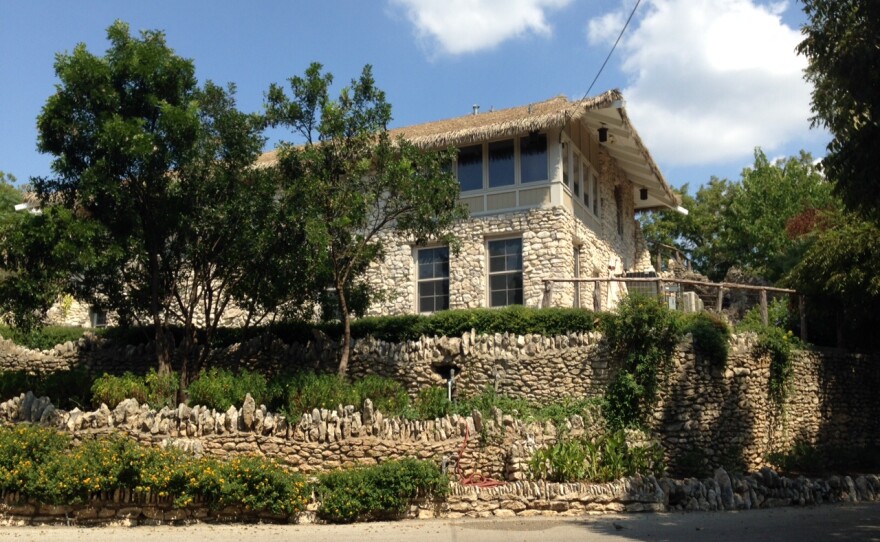You may wonder why the ornate entry gate at San Antonio’s Japanese Tea Garden instead says “Chinese Tea Garden.” The reason links back to a Japanese-American family who once lived in the garden, and altered forever by dramatic events in World War II. The story is a fascinating one, and begins back in 1908 when the future Japanese Tea Garden was just a great big, gaping hole in the ground. It was the remnants of a cement quarry.
“That was the first cement plant west of the Mississippi River, so it was quite a thing in its day,” says San Antonio Parks Operation Supervisor Don Pylant. He says that when the seven-acre quarry played out, Parks Commissioner Ray Lambert planned to re-design it into a water lily garden. Lambert shared the idea with a Japanese American friend, Eizo "Kimi" Jingu, who was an artist and a tea importer. He was also a man of ideas.
“My suspicion is that perhaps they consulted on the design of the tea gardens and maybe that’s how it morphed from the municipal water lily garden into the Japanese Tea Garden,” Pylant says.
So the lily pond became a tea garden, with limestone bridges, stone-lined walkways, Japanese Koi ponds, a huge pagoda and a 60-foot waterfall. Then Lambert offered Kimi a deal.
“He said, 'If I build you a home in the Tea Gardens will you come move there and stay there and help take care of it?' And he said yes.”
Kimi and wife Myoshi moved their young family into the stone home. Five of their six girls and two boys were born there and grew up with the garden as their back yard. The Jingus opened the Bamboo Room Restaurant, serving light lunches and tea. The garden became a popular tourist spot, with the family’s Japanese culture on display as their kimono-wearing daughters served visitors.
Barb Yamadera Cabot is the Jingus' granddaughter. She lives in California, but was raised hearing her mother’s remarkable stories of living in the gardens just a block from the city zoo.
"My mom would say all the time when we’d hear the lions roar that we knew it was going to rain, because the lions were roaring so loud. But can you imagine living in a place like that?"
When a monkey escaped from the zoo and showed up at the garden, one of the girls gave him chewing gum.
"And so when they’d pass the monkey, when he was back in the zoo, he’d look at them and he’d chomp like he was chewing gum. I think he remembered them!" Cabot laughs.
Life in the gardens seemed idyllic until 1938, when father Kimi died suddenly from a heart attack. His widow and children stayed on, but three years later, tragedy again visited the Jingus. Japan attacked Pearl Harbor in 1941.
The United States quickly entered the war and anti-Japanese sentiment ran rampant. More than 100,000 Japanese-Americans were placed in internment camps, mostly on the west coast. While that didn’t happen to the Jingus, the city of San Antonio told them to leave the Tea Garden. Even though son Jimmy joined the Army, earning a Purple Heart, Cabot says the family was no longer welcome in the garden.
“The electricity was turned off, the water was turned off. We didn’t know what to do. Thank goodness, I think it was the Methodist Church helped them find housing. I just can’t even imagine the turmoil they must have felt.”
The city renamed it the Chinese Tea Garden, and a Chinese family named Wu moved in.
"My grandmother had a pretty rough time in those years. I’m sure it was not easy,” Cabot says.
In the 1950s, the Jingus moved to California, putting Texas behind them. Their story might have disappeared were it not for Mayor Henry Cisneros in 1984. As he tried to lure Japanese businesses to the city, the family’s story and the oddly-named Chinese Tea Garden came to his attention. Cisneros decided that after 42 years, the garden should again be known by its original name.
"It seemed like the logical thing to do: to re-name it for the original people who had the idea, did the work and should get credit for it."
The remaining Jingu family returned to San Antonio for the re-naming ceremony, and they've been back several times in the 30+ years since. In 2007 the former family home was officially named The Jingu House. A restaurant bearing their name and showing pictures of the family throughout still serves tea and light lunches. Despite the betrayal so long ago, bitterness has never taken root.
"I get such a wonderful feeling. I get such a..." Cabot chokes back tears. "I’m going to cry. It makes me feel so happy for them because they…for them it was a wonderful life. They loved being there. They only ever talked about how beautiful it was.”
Don Pylant says the Japanese Tea Ceremony may provide a perspective on why the family remains focused on positive memories.
“There’s a term used in Tea Ceremonies called Ichi go Ichi ay. It means one moment, one time and then gone forever.”
He says that means we should treat each moment with others as if it’s our last, because it might just be.
Read more about the Japanese Tea Garden, and the Jingu House Cafe. We've more here on Don Pylant's work with Japanese Gardens.

































